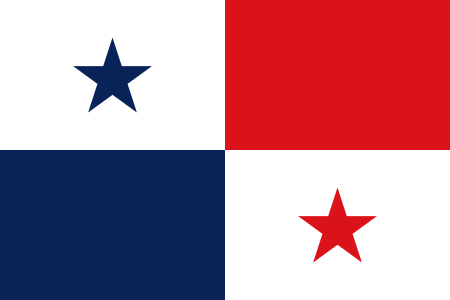Grant Brumpton
Jacob T. Rosalez
La Bandera de la República de Panamá es el más conocido e importante de los símbolos patrios de la República de Panamá. Consiste en un rectángulo dividido en cuatro cuarteles: el superior izquierdo es una estrella azul de cinco puntas sobre fondo blanco; el superior derecho es de color rojo; el inferior izquierdo es de color azul; y el inferior derecho es una estrella roja de cinco puntas sobre fondo blanco.
En el marco de la celebración de las fiestas patrias, cada 4 de noviembre se celebra en Panamá el Día de la Bandera, como fiesta nacional. Con motivo de esta gran celebración se realizan actos conmemorativos como desfiles y ceremonias, en los cuales se le rinde tributo a la bandera.
¡Más en inglés aquí!

Capital y Ciudad más poblada
Ciudad de Panamá
Población: 4151,121 (2005)

Organización territorial de Panamá
División política de Panamá
Provincias
Bocas del Toro, capital Bocas del Toro.
Chiriquí, capital David
Coclé, capital Penonomé
Colón, capital Colón.
Darién, capital La Palma
Herrera, capital Chitré
Los Santos, capital Las Tablas
Panamá, capital Ciudad de Panamá
Veraguas, capital Santiago de Veraguas



PANAMA HAT
United States invasion of Panama
Main article: United States invasion of Panama
On 20 December 1989, twenty-seven thousand US personnel [1] invaded Panama in order to remove Noriega. A few hours before the invasion, in a ceremony that took place inside a U.S. military base in the former Panama Canal Zone, Guillermo Endara (winner of the May 1989 elections) was sworn in as the new President of Panama. The invasion occurred ten years before the Panama Canal administration was to be turned over to Panamanian control, according to the timetable set up by the Torrijos-Carter Treaties. After the invasion, Noriega sought asylum in the Vatican diplomatic mission represented by Monsignor Jose S. Laboa. To induce Noriega's surrender, US forces played loud music outside the embassy which reportedly included the song "Panama," by the 1980s rock group, Van Halen. (WSJ) After a few days, the embassy staff talked loudly for his benefit about the possibility that the mob surrounding them might break through and lynch Noriega. He surrendered to the American military shortly after, and was taken to Florida to be formally extradited and charged by U.S. federal authorities. He is eligible for parole in September of 2007, but the Panamanians want him for trial on charges of murder.
Under the Torrijos-Carter Treaties, the United States returned all canal-related lands to Panama on 31 December 1999, but reserves the right to military intervention in the interest of its national security. Panama also gained control of canal-related buildings and infrastructure as well as full administration of the canal.
The people of Panama have already approved the widening of the canal which, after completion, will allow for post-Panamax vessels to travel through it, increasing the number of ships that currently use the canal.
Panama's politics takes place in a framework of a presidential representative democratic republic, whereby the President of Panama is both head of state and head of government, and of a pluriform multi-party system. Executive power is exercised by the government. Legislative power is vested in both the government and the National Assembly. The judiciary is independent of the executive and the legislature.
For More Information On Panama Visit http://en.wikipedia.org/wiki/Panama









